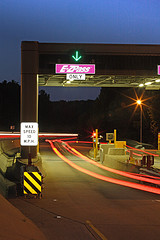
Brace yourself for a slew of new toll roads in Virginia. E-ZPass will make it a breeze to pay the tolls, but it won’t ease the suspicion that people in “other parts of the state” are getting a sweeter deal.
by James A. Bacon
Between the 495 Express Lanes project and the Downtown/Midtown Tunnel, Virginians will be paying a lot more in tolls by the end of the year. The Virginia Department of Transportation estimates that 400,000 new drivers will enroll in the E-ZPass electronic-payment system, compared to 900,000 presently, and Transportation Secretary Sean Connaughton wants to make sure that VDOT can accommodate the surge.
Virginia already allows motorists to set up E-ZPass accounts and order the transponders online. But VDOT hopes to supplement that distribution with a retail distribution network that includes the Division of Motor Vehicles, big-box stores and other outlets.
Hampton Roads drivers are expected to start paying tolls on the Midtown Tunnel, Downtown Tunnel and Martin Luther King Boulevard by the third quarter this year, while Northern Virginians will require the transponders to use the tolled HOT lanes on the Capital Beltway by the end of the year. Never before has VDOT had to distribute so many transponders in such a short time frame. “It will be a significant challenge to get that many transponders to the public,” said Virginia Highway Commissioner Gregory A. Whirley at a meeting of the Commonwealth Transportation Board today.
Connaughton expressed concern that VDOT does not yet have vendor contracts in place to deliver 400,000 transponders nor the retail network to distribute them. Having the electronic payment system in place is critical for a smooth launch of the multibillion-dollar public-private partnerships in Hampton Roads and Northern Virginia, he said. “If we don’t get this right, it will be a black mark.” He told VDOT officials that he expects monthly updates on E-ZPass at future meetings.
“It’s all underway,” John Lawson, VDOT’s chief financial officer, assured him.
VDOT will get help from its private-sector partners, Transurban-Fluor in Northern Virginia and Elizabeth River Crossings in Hampton Roads. Both public-private partnership (P3) operators would prefer to collect their tolls electronically rather than resort to other means such as tracking down motorists on the basis of license-plate images captured by video cameras. The administration costs for E-ZPass are far lower than the alternatives, which means lower costs for drivers and less hassle for the franchise operators.
Transburban-Fluor plans a major roll-out when the HOT/HOV lanes open for business in December, said Jennifer Aument, vice president-corporate relations for Transurban USA. 495 Express Lanes will have to educate drivers about new traffic patterns, who gets to use the express lane for free (buses, vans, carpools), who has to pay, and how to sign up for the transponders. The partnership expects to unleash a promotional campaign that includes ads in the Washington Post, 100 delivery trucks acting as mobile billboards, festival promotions and meetings with targeted stakeholders. The company has developed the graphics for fliers and other collateral material and has developed a core message, “It’s time to change lanes.” Of course, she added, the roll-out will be Tweeted.
495 Express Lanes hopes to generate 400,000 customer interactions by March 2013 and to convert them into 100,000 transponder sign-ups.
Likewise, Elizabeth River Crossing (ERC) has created a tolling strategy and marketing plan, which it has submitted to VDOT for review, said Greg Woodsmall, interim CEO of the partnership. ERC has a tougher job than Transurban and Fluor, however. No one will be forced to pay the HOT lane tolls on the Beltway; drivers can continue using the old Beltway lanes at no cost. By contrast, commuters using the Norfolk-to-Portsmouth tunnels will start paying tolls for tunnels that they are accustomed to using for free — before the improvements are even completed. Hundreds of citizens gathered in Portsmouth recently to protest the tolls, and scores offered to join as plaintiffs in a lawsuit expected to be filed by next week.
Some 10% to 15% of Hampton Roads drivers already have E-ZPass. ERC’s goal is to get that number to 50% when the tolls are put in place, and eventually to 90%, said Woodsmall. Reaching the 50% goal will require distributing 80,000 transponders. Toll payers will be required to pay VDOT $35 up-front, which includes the cost of the transponder and a credit toward use of the tolled facilities. When the credit is used up, VDOT will draw from the driver’s bank account and/or credit card. “It’s a tough sell to charge for an advance payment,” acknowledged Woodsmall. ERC will offer an alternative — paying for each use of the facilities in a “pay by plate” arrangement. But that entails a lot more administrative work, and the charge can be three times the transponder fee, or nearly $5.
Discussion of the tolling technology stimulated a variety of comments. Dana Martin, the Salem transportation district representative, said that the “photo enforcement” of the Hampton Roads tolls would unfairly punish drivers from outside the region — in Charlottesville or Lynchburg, say — who have no tolls and no reason to acquire a transponder. Why should they have to pay three times as much as locals do?
That inspired a response from Shep Miller, an urban at-large representative from Norfolk, who said, “At least you don’t have to pay every day just to get to work!” Miller elaborated in later remarks, saying that paying $900 a year in tolls to get to work represents a genuine hardship for someone making $15,000 a year.
Connaughton leaped into the fray, asking, “What’s the situation you have today?” Commuters spend a half an hour daily stuck in traffic at the two Norfolk-to-Portsmouth tunnels, he said. His implication was that paying the tolls was preferable to sitting idle in traffic.
Miller retorted that when the state fixes “other peoples’ problems” in other parts of the state, it doesn’t slap tolls on the projects. Other CTB members joined in, decrying how different regions of the state are treated differently when it comes to paying tolls. Then Jim Rich, Culpeper district representative, quipped that the state was welcome to take back the $244 million committed to the Charlottesville Bypass — which he opposed — to buy down tolls in Northern Virginia and Norfolk.
In the end, Miller agreed that the McDonnell administration has no choice but to create toll-driven projects in a political environment in which Virginia legislators are unwilling to raise the motor fuels tax, or even to adjust it for inflation. Said he: “The problem is that previous administrations did nothing for so long, there is no alternative.”
Update: Here is Debbie Messina’s story in the Virginian-Pilot.




